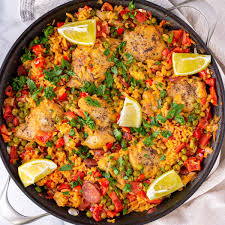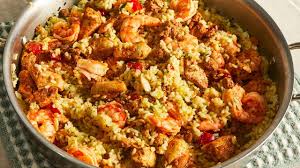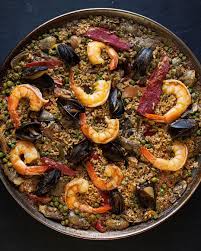Introduction
Paella is one of Spain’s most famous and beloved dishes — a colorful, flavorful rice-based meal that represents the heart of Spanish cuisine. Originating from Valencia, Paella has become a symbol of Spanish culture, celebration, and healthy Mediterranean eating.
This dish combines rice, vegetables, seafood, meat, and aromatic spices, creating a meal that’s not only delicious but also packed with nutrients. In this article, we’ll explore the history, ingredients, health benefits, types, and cultural importance of Paella — and why it’s considered one of the world’s healthiest and most satisfying dishes.
The Origin and History of Paella
Paella comes from Valencia, a region on Spain’s eastern coast, known for its fertile fields and access to fresh seafood. The word “paella” actually means “frying pan” in Valencian, referring to the wide, shallow pan traditionally used to cook the dish.
The original Valencian Paella (Paella Valenciana) dates back to the mid-19th century, when farmers combined rice with vegetables, snails, and meat like chicken or rabbit. Over time, as trade and travel expanded, seafood and other ingredients were added, giving rise to the famous Seafood Paella and Mixed Paella.
Today, Paella is not just a dish — it’s a symbol of community, sharing, and Spanish tradition, often enjoyed at family gatherings, festivals, and special occasions.
The Key Ingredients in Paella
The magic of Paella lies in its fresh, natural ingredients. Each one contributes not only flavor but also important nutrients that make the dish healthy and wholesome.
1. Rice
The base of Paella is short-grain rice, typically Bomba or Calasparra rice. These varieties absorb flavors beautifully while maintaining their texture.
-
Health Benefits: Provides complex carbohydrates for long-lasting energy, rich in fiber, and naturally gluten-free.
2. Olive Oil
A staple of Mediterranean cuisine, extra virgin olive oil is used to sauté the ingredients.
-
Health Benefits: High in monounsaturated fats and antioxidants; supports heart health and reduces inflammation.
3. Seafood and Meat
Depending on the recipe, Paella can include shrimp, mussels, clams, squid, chicken, or rabbit.
-
Health Benefits: Lean proteins promote muscle repair and strength, while seafood adds omega-3 fatty acids for heart and brain health.
4. Vegetables
Tomatoes, bell peppers, green beans, peas, and artichokes add color and nutrition.
-
Health Benefits: Rich in vitamins, fiber, and antioxidants that boost immunity and aid digestion.
5. Saffron
Saffron is the signature spice that gives Paella its golden color and distinct aroma.
-
Health Benefits: Contains powerful antioxidants; supports mood regulation and may improve memory.
Types of Paella
1. Paella Valenciana (Traditional)
Made with rabbit, chicken, green beans, and occasionally snails — the original Valencian version.
2. Seafood Paella (Paella de Marisco)
Uses fresh seafood such as shrimp, mussels, and squid. No meat or beans, making it lighter and rich in omega-3 fatty acids.
3. Mixed Paella (Paella Mixta)
Combines both seafood and meat, offering a rich and hearty flavor profile.
4. Vegetarian Paella
Made with seasonal vegetables, mushrooms, and legumes — perfect for plant-based diets.
Health Benefits of Paella
1. Supports Heart Health
Thanks to ingredients like olive oil, seafood, and vegetables, Paella aligns with the Mediterranean diet, known for promoting heart health and reducing cholesterol levels.
2. Rich in Nutrients and Protein
Paella is a balanced meal containing protein, fiber, vitamins, and minerals. The combination of rice and vegetables ensures sustained energy and muscle recovery.
3. High in Antioxidants
Vegetables, olive oil, and saffron contain natural antioxidants that help fight free radicals and slow down aging.
4. Boosts Brain and Mood
Omega-3 fatty acids in seafood and the natural compounds in saffron support mental clarity, focus, and emotional well-being.
5. A Balanced Meal
Unlike many fried or processed dishes, Paella uses fresh, whole ingredients cooked in healthy oils. It provides a good balance of carbohydrates, proteins, and healthy fats — ideal for a complete meal.
How to Make Healthy Paella at Home
Here’s a simplified version of a healthy, delicious Paella you can try:
Ingredients:
-
2 cups short-grain rice (Bomba or Arborio)
-
4 cups low-sodium chicken or vegetable broth
-
2 tablespoons olive oil
-
1 cup chopped tomatoes
-
1 red bell pepper, sliced
-
1 cup green beans or peas
-
1 lb mixed seafood (shrimp, mussels, squid) or chicken
-
A pinch of saffron threads
-
Salt, pepper, and smoked paprika to taste
-
Lemon wedges for garnish
Instructions:
-
Heat olive oil in a wide pan.
-
Sauté your meat or seafood until slightly browned.
-
Add tomatoes, vegetables, and seasonings; cook until softened.
-
Stir in the rice, coating it in oil and spices.
-
Add broth and saffron; simmer until the rice absorbs the liquid (about 20 minutes).
-
Let rest for a few minutes before serving.
-
Garnish with lemon wedges and parsley.
Paella and Spanish Culture
In Spain, Paella is more than food — it’s a social event. Families and friends gather around large pans to share the meal, often cooked outdoors over an open flame. Sundays and holidays are traditional days for Paella feasts, especially in Valencia.
It’s also a symbol of unity and pride. Each region in Spain has its own version, reflecting local ingredients and culture. The dish embodies the Mediterranean values of sharing, balance, and enjoying life through food.
Conclusion
Paella is not just Spain’s national dish; it’s a masterpiece of flavor, nutrition, and tradition. With its vibrant mix of rice, vegetables, olive oil, and seafood or meat, Paella delivers incredible health benefits while celebrating the joy of eating together.
Whether you enjoy it in a seaside restaurant in Valencia or cook it at home, Paella remains a beautiful example of healthy Mediterranean cuisine — a dish that nourishes the body and the soul.




You must be logged in to post a comment.